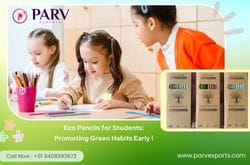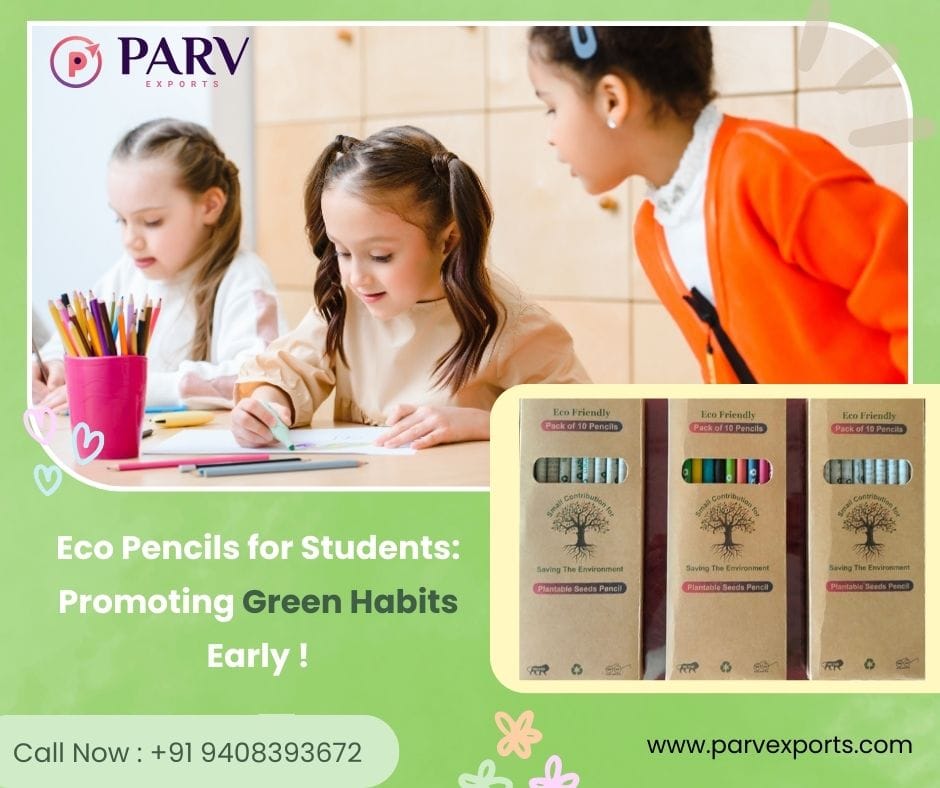

In an era where environmental sustainability is no longer a choice but a necessity, small lifestyle changes can create a significant impact. One such simple yet powerful shift is the adoption of eco-friendly pencils, especially in the hands of students. As educational institutions and parents seek to instill eco-conscious values, eco pencils serve as an ideal tool to teach environmental responsibility from a young age.
This blog explores the importance of eco pencils in educational settings, their benefits for both students and the environment, and how promoting sustainable habits early can lead to a greener future.
What Are Eco Pencils?
Eco pencils are writing instruments made from sustainable, biodegradable, or recyclable materials. Unlike traditional wooden pencils that often rely on deforestation and plastic-wrapped alternatives that contribute to pollution, eco pencils are designed to minimize environmental impact.
Common materials used in eco pencils:
Recycled paper
Plantable seed paper
Bamboo
Biodegradable plastics
Newspaper rolls
Some eco pencils even contain seeds at the end so that once the pencil becomes too short to use, it can be planted and grown into a herb, vegetable, or flower—a brilliant blend of functionality and sustainability.
Why Students Are the Best Ambassadors for Green Habits
Children are naturally curious and eager to learn, making them ideal ambassadors for change. Introducing eco-friendly tools like sustainable pencils at a young age builds an understanding of environmental stewardship. When students learn the importance of using eco products, they are more likely to adopt a lifestyle that prioritizes sustainability.
Benefits of early eco-education include:
Building long-term eco-conscious behaviors
Developing critical thinking about environmental issues
Encouraging responsibility and mindfulness
Influencing peers and even adults through example
By incorporating green products into daily learning, educators and parents are shaping a generation that thinks differently and acts responsibly.
Educational Impact of Eco Pencils in Schools
Eco pencils do more than just reduce waste—they open up opportunities for learning. Teachers can use these tools to introduce important topics such as:
Recycling and waste management
Sustainable product design
Climate change and deforestation
Conservation of natural resources
This way, students don’t just use an eco pencil—they understand its journey from sustainable materials to classroom use, and often, to garden soil if it’s plantable.
Example:
A classroom project where students plant the seed-end of their pencils and observe the growth process can combine lessons in biology, environmental science, and personal responsibility.
Environmental Benefits of Eco Pencils
Using eco pencils can greatly reduce the carbon footprint of educational institutions. Millions of wooden pencils are used annually across the globe. Each pencil may seem small, but collectively, they require cutting down thousands of trees.
Key environmental benefits of eco pencils:
Reduce deforestation by using recycled or alternative materials
Lower carbon emissions in production and disposal
Minimize landfill waste
Promote biodiversity when plantable pencils are used
Support circular economy through recyclable and reusable designs
When schools switch to eco-friendly stationery, they make a statement about their values and commitment to sustainability.
Types of Eco Pencils for Students
There are various types of eco pencils that cater to different needs and preferences:
1. Recycled Paper Pencils
These pencils are made from tightly rolled recycled paper instead of wood. They are durable, non-toxic, and often look colorful due to the paper layers.
2. Plantable Seed Pencils
These unique pencils come with a seed capsule at the end. When the pencil becomes too short to use, students can plant it in soil and watch it grow into basil, marigold, tomato, or other plants.
3. Newspaper Pencils
Crafted from discarded newspapers, these pencils are an excellent example of upcycling waste material into something useful and creative.
4. Bamboo Pencils
Bamboo, being a fast-growing plant, is a sustainable alternative to traditional wood. These pencils are biodegradable and strong.
5. Compostable Pencils
Made from compostable materials, these pencils decompose naturally without harming the environment when discarded.
How Parents and Schools Can Encourage Use of Eco Pencils
Promoting eco pencils starts with awareness and accessibility. Parents and schools play a key role in introducing students to sustainable stationery.
Ways to encourage eco pencil use:
Include eco pencils in school supply lists
Conduct classroom workshops about sustainability
Organize “green days” where students use only eco-friendly products
Reward green behavior with plantable pencil kits
Collaborate with eco-conscious brands for school supplies
These simple strategies not only promote green products but also help create a culture of environmental mindfulness in students’ daily routines.
Cost vs. Value: Are Eco Pencils Worth It?
Eco pencils are slightly more expensive than standard ones, especially if they’re plantable or made from specialty materials. However, the value they offer in education, environmental impact, and long-term habit formation far outweighs the cost.
By investing a bit more, parents and schools are teaching students to value quality, sustainability, and social responsibility.
Long-term value includes:
Healthier planet
Responsible consumers
Better educational engagement
Creative thinking and innovation
Making Sustainability Fun for Students
For children, learning sticks when it’s engaging and interactive. Eco pencils, especially plantable ones, provide a hands-on approach to sustainability. Watching a pencil turn into a flower or herb creates a sense of wonder and personal involvement.
Fun ideas:
Track plant growth in eco-journals
Create art and label it with “Made with eco pencils!”
Host “Grow Your Pencil” competitions
Share stories about their planted pencils at school assemblies
Such activities not only educate but also entertain—making sustainability an exciting part of student life.
Conclusion: Writing a Greener Tomorrow
The road to sustainability starts with small, thoughtful choices—and switching to eco pencils is one of them. For students, these pencils are more than just writing tools—they are symbols of care, responsibility, and awareness. By introducing eco pencils early in life, we’re helping raise a generation that values the environment and contributes actively toward protecting it.
Whether it’s through planting a pencil or learning about recycling, the message is clear: every student has the power to write a greener, brighter future—one eco pencil at a time.
Let’s equip students not just with the tools to learn, but with the values to lead. Choose eco pencils. Inspire change.